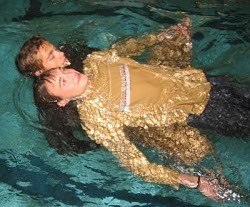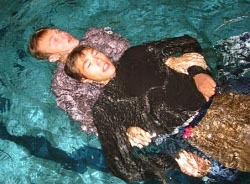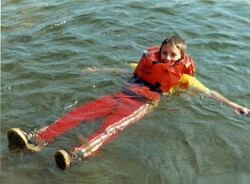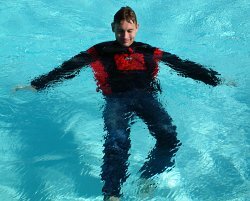Backstroke for Towing Casualties
Survival backstroke can get you out of trouble without using too much energy. Turn on your back and move with breaststroke kick and sculling hands, a gentler version of breaststroke arms.
Backstroke has the advantage of easy breathing, as the mouth and nose are almost always out of the water.
The disadvantage is you can't see where you're going, unless you turn your head often.
This swimming style is similar to an upside down breaststroke.
Learn Backstroke in Easy Steps
First, practice the leg kick while sitting on the edge of the pool. The leg kick is like inverted breaststroke. Use this three part sequence:
- Kick out, legs apart.
- Bring the legs together.
- Pull the legs back in.
Practice with a Float
Using a float to support your upper body, do this:
- With breaststroke leg kick, swim on your back, keep your knees under the water.
Turn out your feet to get a strong propulsive kick.
- Do the leg kick on your back with your arms sculling by your side.
- Do the leg kick with your arms crossed over your chest.
- Move efficiently over an increasing distance using this leg kick.
- Use the leg kick while towing another person.
Oar Stroke / Moth Stroke
The oar stroke consists of the opposite motions of the butterfly stroke, hence the alternate name: Moth Stroke.
Unlike the butterfly stroke you are swimming in a backwards direction. Move your arms in a circular motion akin to the butterfly stroke. The legs are however, kicked out like with breaststroke.
The Moth Stroke is not to be confused with the "slow butterfly stroke" which also can be alternately labelled as the "moth stroke."
Practice Tip: Lie on a Float
If you have difficulty keeping your legs up while at the same time your arms reach forward above the water,
lie on a float to begin with, until you can do it right.
Lifesaver's Backstroke
Lifesaving backstroke is the same, except you would be rescuing someone. Lifesavers use the breaststroke kick differently. The legs are somewhat lower, the knees are not pulled in as much because this would mean kicking the casualty. Instead, the lower legs do most of the kicking, in a rotation below the knee.


Harder Training
Once you've mastered this swimming stroke, you can increase the training level. Spread your arms sideways and swim lifesaving backstroke using the legs only. Hold your hands vertical to get maximum resistance. This gives you a similar workout to rescue towing, slows you down as much as a casualty would.

Try it with a lifejacket.
